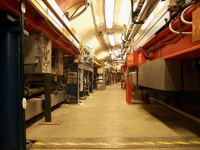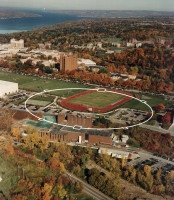 |
 |
|||||||||||||
|
|||||||||||||
|
|||||||||||||
|
Sometimes even pretty straightforward and remarkably logical ideas take several moves before they become a reality. Take the planned damping rings for the ILC, for example. In the ILC, compact bunches of electrons and positrons are made to collide at very high energy. In order to ensure a high rate of particle collisions, the bunches are cooled in damping rings prior to acceleration. In a cold bunch, the particles are all very close together and travelling in very nearly the same direction with very nearly the same velocity. (In a hot bunch, as in a hot pot of water, the particles are more dispersed and are all moving in different directions.) In order to cool the particles, accelerator experts send them through damping wigglers – a series of superconducting magnets that forces the electrons and positrons on a wiggly path so that they lose energy in the form of synchrotron radiation: X-ray photons. Physicists have installed superconducting wiggler magnets in the Cornell Electron Storage Ring (CESR) and know that the powerful magnets indeed reduce the size of the bunches. Unfortunately the intense flux of photons generated by the wigglers doesn't just disappear. Instead, they hit the beam pipe, knocking out electrons from the vacuum chamber surface and into the path of the beam. These electrons are kicked by the beam and then strike the walls of the pipe again, emitting even more electrons, until a whole cloud forms that can destabilise the beam, jeopardising the whole idea of damping, which of course was the starting point. So that means you have to study how to inhibit the development of the electron cloud, and learn how to mitigate the effect of the cloud on the bunches of electrons and positrons. Imagine that you happen to have a machine that has many of the properties that an ILC damping ring would have: it's circular, it can accelerate and store electrons and positrons, and it has many wigglers because in its recent past wigglers were installed to improve the performance of the storage ring as a low-energy electron-positrion collider.You write an internationally supported proposal to transform it into a damping ring test accelerator after its life as a high-energy machine and light source is over, this proposal gets accepted and you're good to go! This, in short, is the story of CESR, the Cornell Electron Storage Ring run by Cornell University in the state of New York, US. Mark Palmer is project manager of CESR-TA (for test accelerator), and these days he is very busy with the installation of the first chambers to monitor the build-up of the electron cloud in CESR. Despite much confusion early in the year and thanks to lots of support and emergency plans from around the world, the project of converting the now switched-off CESR is almost on track. Of course it's not as simple as switching it off and then on again as something else – changes need to be made to prepare the future test facility... The team first has to get the CESR emittance – a description of how tightly the particle bunch is packed, or the temperature of the bunch – down. “For that we need instruments to both achieve and measure the low emittance,” says Palmer. The wigglers also have to be relocated to positions in the ring where their damping effects are optimal. This will happen during a down period later in 2008. In the meantime, the first set of chambers instrumented to study the growth of the electron cloud are being installed during a downtime this week. These first tests will both serve to validate the performance of the electron cloud detectors as well as obtain some of the first key physics measurements. The tests will help them figure out both how best to design the special vacuum chambers and how to limit the formation of electron clouds in the ILC damping rings. In about a month CESR will undergo another set of changes, a major reconfiguration which will include instrument upgrades and installation of additional vacuum chambers inside the wiggler magnets. The wiggler chambers are currently being fabricated at Lawrence Berkeley National Lab and are a collaborative effort between Cornell, Berkeley, KEK and SLAC. “Many people have come together to make this work,” says Palmer. The next run (already under the new name CESR-TA) starts in autumn to commission the new ring and test the instruments. “Our goal is to have the major parts of the machine upgrade complete by mid-2009 so that we can really focus on detailed electron cloud studies at an operating emittance approaching that planned for the ILC damping rings during the final year of the programme,” says Palmer. -- Barbara Warmbein |
|||||||||||||
| © International Linear Collider |

